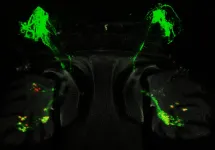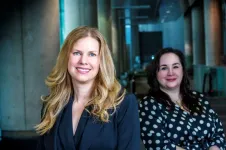(Press-News.org) As researchers push the boundaries of battery design, seeking to pack ever greater amounts of power and energy into a given amount of space or weight, one of the more promising technologies being studied is lithium-ion batteries that use a solid electrolyte material between the two electrodes, rather than the typical liquid.
But such batteries have been plagued by a tendency for branch-like projections of metal called dendrites to form on one of the electrodes, eventually bridging the electrolyte and shorting out the battery cell. Now, researchers at MIT and elsewhere have found a way to prevent such dendrite formation, potentially unleashing the potential of this new type of high-powered battery.
The findings are described in the journal Nature Energy, in a paper by MIT graduate student Richard Park, professors Yet-Ming Chiang and Craig Carter, and seven others at MIT, Texas A&M University, Brown University, and Carnegie Mellon University.
Solid-state batteries, Chiang explains, have been a long-sought technology for two reasons: safety and energy density. But, he says, "the only way you can reach the energy densities that are interesting is if you use a metal electrode." And while it's possible to couple that metal electrode with a liquid electrolyte and still get good energy density, that does not provide the same safety advantage as a solid electrolyte does, he says.
Solid state batteries only make sense with metal electrodes, he says, but attempts to develop such batteries have been hampered by the growth of dendrites, which eventually bridge the gap between the two electrode plates and short out the circuit, weakening or inactivating that cell in a battery.
It's been known that dendrites form more rapidly when the current flow is higher -- which is generally desirable in order to allow rapid charging. So far, the current densities that have been achieved in experimental solid-state batteries have been far short of what would be needed for a practical commercial rechargeable battery. But the promise is worth pursuing, Chiang says, because the amount of energy that can be stored in experimental versions of such cells, is already nearly double that of conventional lithium-ion batteries.
The team solved the dendrite problem by adopting a compromise between solid and liquid states. They made a semisolid electrode, in contact with a solid electrolyte material. The semisolid electrode provided a kind of self-healing surface at the interface, rather than the brittle surface of a solid that could lead to tiny cracks that provide the initial seeds for dendrite formation.
The idea was inspired by experimental high-temperature batteries, in which one or both electrodes consist of molten metal. According to Park, the first author of the paper, the hundreds-of-degrees temperatures of molten-metal batteries would never be practical for a portable device, but the work did demonstrate that a liquid interface can enable high current densities with no dendrite formation. "The motivation here was to develop electrodes that are based on carefully selected alloys in order to introduce a liquid phase that can serve as a self-healing component of the metal electrode," Park says.
The material is more solid than liquid, he explains, but resembles the amalgam dentists use to fill a cavity -- solid metal, but still able to flow and be shaped. At the ordinary temperatures that the battery operates in, "it stays in a regime where you have both a solid phase and a liquid phase," in this case made of a mixture of sodium and potassium. The team demonstrated that it was possible to run the system at 20 times greater current than using solid lithium, without forming any dendrites, Chiang says. The next step was to replicate that performance with an actual lithium-containing electrode.
In a second version of their solid battery, the team introduced a very thin layer of liquid sodium potassium alloy in between a solid lithium electrode and a solid electrolyte. They showed that this approach could also overcome the dendrite problem, providing an alternative approach for further research.
The new approaches, Chiang says, could easily be adapted to many different versions of solid-state lithium batteries that are being investigated by researchers around the world. He says the team's next step will be to demonstrate this system's applicability to a variety of battery architectures. Co-author Viswanathan, professor of mechanical engineering at Carnegie Mellon University, says, "We think we can translate this approach to really any solid-state lithium-ion battery. We think it could be used immediately in cell development for a wide range of applications, from handheld devices to electric vehicles to electric aviation."
INFORMATION:
The team also included Christopher Eschler, Cole Fincher, and Andres Badel at MIT; Pinwen Guan at Carnegie Mellon University; and Brian Sheldon at Brown University. The work was supported by the U.S. Department of Energy, the National Science Foundation, and the MIT-Skoltech Next Generation Program.
Written by David L. Chandler, MIT News Office
Paper: "Semi-solid alkali metal electrodes enabling high critical current densities in solid electrolyte batteries."
https://www.nature.com/articles/s41560-021-00786-w
Even though a fruit fly doesn't have ears, it can hear with its antennae. In a END ...
The first known study to explore optimal outpatient exam scheduling given the flexibility of inpatient exams has resulted in shorter wait times for magnetic resonance imaging (MRI) patients at END ...
FINDINGS
A new UCLA study shows that while men and women who have high muscle mass are less likely to die from heart disease, it also appears that women who have higher levels of body fat -- regardless of their muscle mass -- have a greater degree of protection than women with less fat.
The researchers analyzed national health survey data collected over a 15-year period and found that heart disease-related death in women with high muscle mass and high body fat was 42% lower than in a comparison group of women with low muscle mass and low body fat. However, women who had high muscle mass and low ...
A global review of coastal drowning science has found there is only one study worldwide that has evaluated beach safety education programs in schools.
Researchers from UNSW's Beach Safety Research Group have conducted the first in-depth review specific to coastal drowning.
The study, published in PLOS ONE, reviewed 146 coastal drowning studies from around the world.
"We found that evaluation of coastal drowning prevention strategies is rare," said William Koon, the lead author of the study and a PhD candidate in the School of Biological, Earth ...
The National Science Foundation (NSF) selected an NYU Tandon School of Engineering professor who is developing new approaches to training deep learning (DL) artificial intelligence frameworks, to receive its most prestigious award for promising young academics.
Anna Choromanska, an assistant professor in the Department of Electrical and Computer Engineering (ECE), received a 2021 NSF Faculty Early Career Development Award, more widely known as a CAREER Award, which supports early-career faculty who have the potential to serve as academic role models in research and education.
A five-year, $532,892 grant will support a project that focuses on new, more efficient ways of training ...
The continuous improvement of imaging technology holds great promise in areas where visual detection is necessary, such as with cancer screening. Three-dimensional imaging in particular has become popular because it provides a more complete picture of the target object and its context.
"More doctors and radiologists are looking at these 3D volumes, which are new technologies that allow you to look not just at one image, but a set of images," said UC Santa Barbara psychology professor Miguel Eckstein(link is external), whose expertise lies in the field of visual search. "In some imaging modalities this gives doctors information about volume and it allows them to segment what they're interested in."
Common wisdom is that with all ...
Bring on Twilight. Lee Child's Jack Reacher? Yes, please. More of James Patterson's Alex Cross while we're at it. And let's finish off with revisiting the million-plus words of the Harry Potter saga.
No one will confuse the above book series with high literature. But a new study published in the journal Reading and Writing shows that the more people read any kind of fiction -- even mass market stuff sniffily derided as pulp -- the better their language skills are likely to be.
The piece was written by Sandra Martin-Chang, professor of education in the Faculty of Arts and Science, and PhD student Stephanie Kozak. They found that people who enjoyed reading fiction for leisure and who identified as a reader scored higher on language tests, whereas ...
It's not uncommon for crescent-shaped swaths of sand to dot the shorelines of meandering rivers. These swaths usually appear along the inner side of a river bend, where the bank wraps around the sandy patch, forming deposits known as a "point bars."
When they appear along an outer bank, which curves the opposite way, they form "counter-point" bars, which are usually interpreted by geoscientists as an anomaly: a sign that something - such as a patch of erosion-resistant rocks - is interfering with the river's usual manner of sediment deposition.
But according to research led by The University of Texas at Austin, counter-point bars are not the oddities they're often ...
PHILADELPHIA (March 16, 20201) - After a traumatic injury, returning to work (RTW) can be a strong indication of healing and rehabilitation and may play a pivotal role in promoting physical and functional recovery. But how does RTW after a traumatic injury affect mental health recovery, particularly in individuals who experience social and economic marginalization?
In a new study from the University of Pennsylvania School of Nursing (Penn Nursing), researchers investigated the ways that RTW after an injury predict mental health outcomes in Black men living and recovering in Philadelphia. The study found that men ...
AI has, for some time, been applied to diagnose medical conditions in specific fields. It can build on knowledge of particular disciplines to hone in on details such as the shape of a tumor that suggests breast cancer or abnormal cells that indicate cervical cancer. While AI is very good when trained on years of human data in specific domains, it has not been able to deal with the huge number of diagnostic tests (about 5000) and disorders (about 14,000) of modern clinical practice. Now, a new algorithm developed by engineers at the USC Viterbi School of Engineering can think and learn just like a doctor but with essentially infinite experience.
The work comes out of the lab of Gerald Loeb, a professor ...


